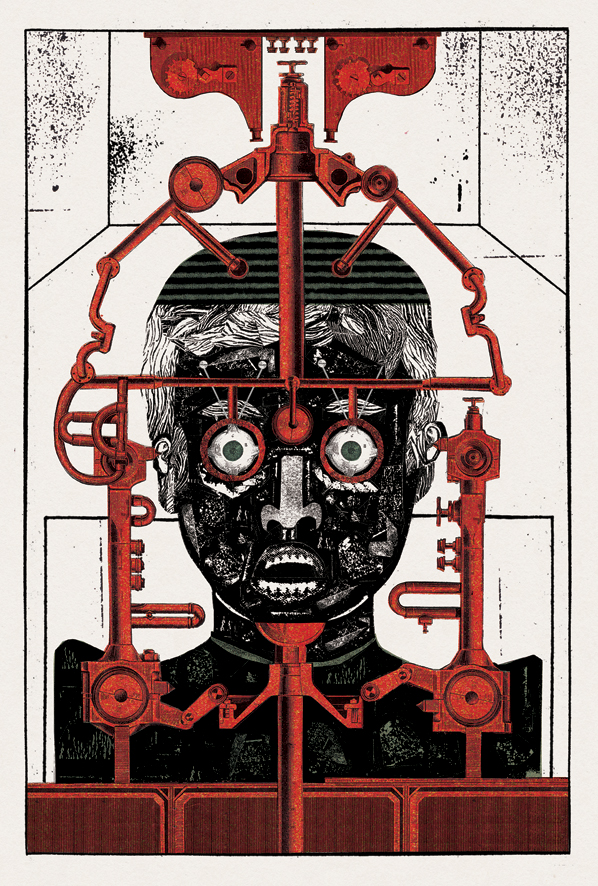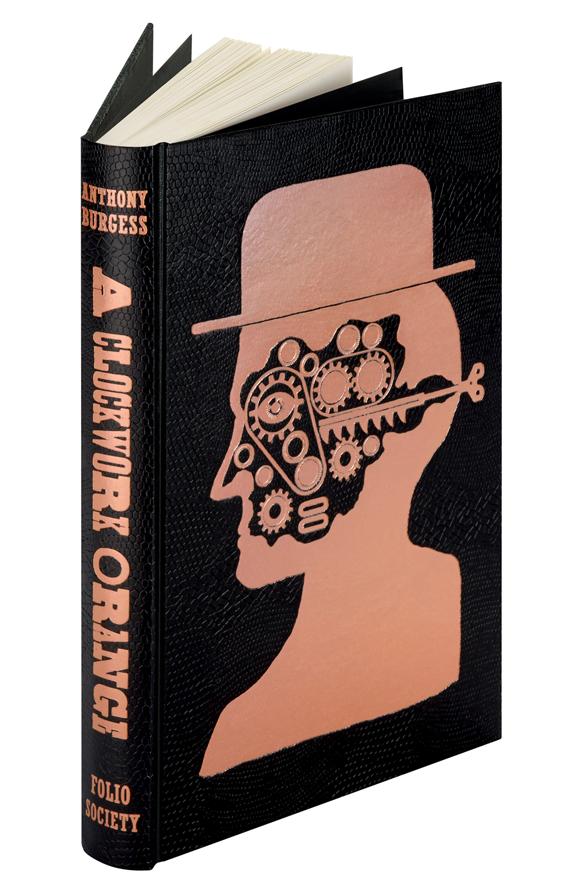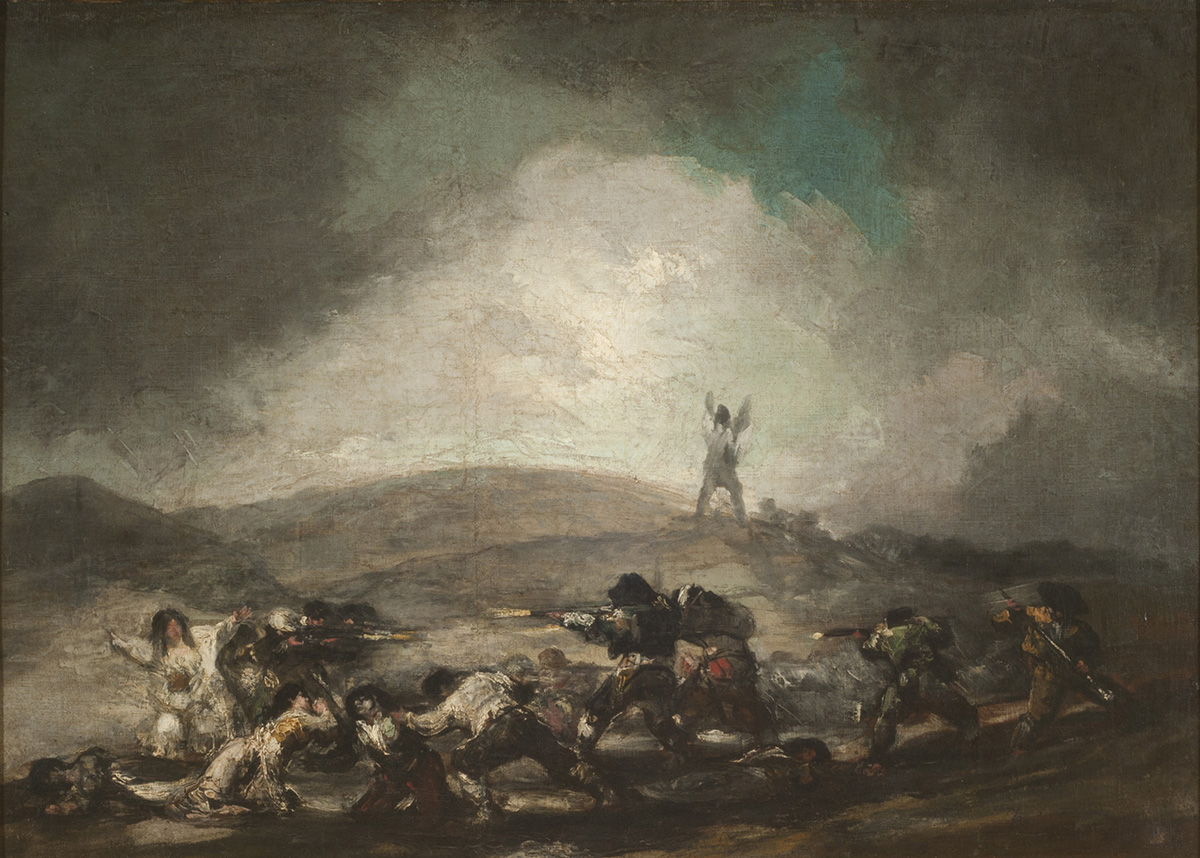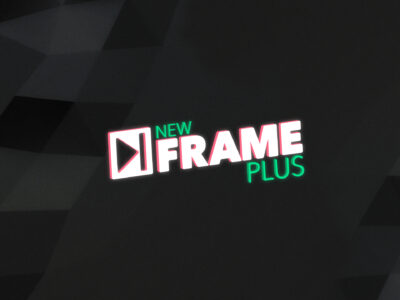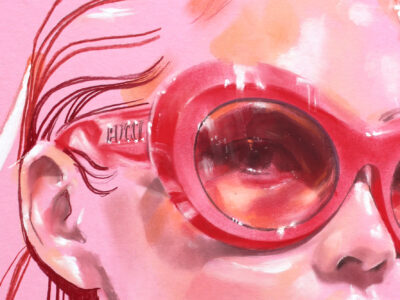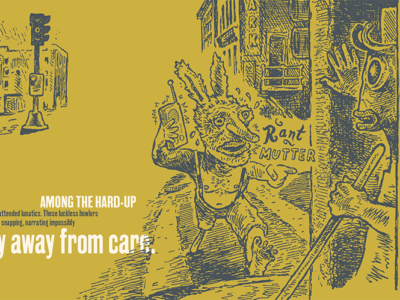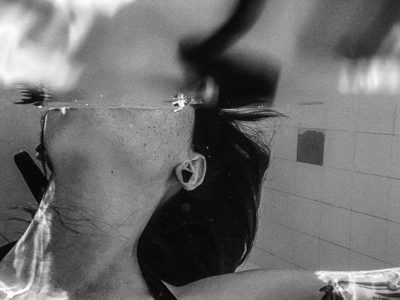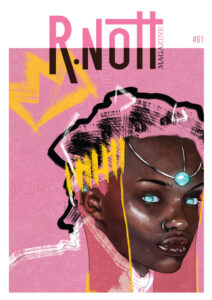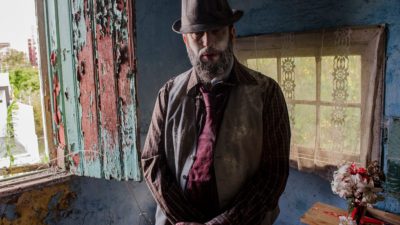Entrevistamos o ilustrador inglês Ben Jones e apresentamos seu sensacional trabalho com impressões e colagem. Seus trabalhos já ilustraram obras como a Laranja Mecânica de Burgess e 1984, de Orwell, e você pode vê-los aqui!
“Meus personagens geralmente são inspirados por uma combinação de figuras ficcionais e políticas. Eu tento fazer com que sejam levemente perturbadores.”
♦ Como, onde, quando e por quê.
Eu sou um ilustrador, tenho 30 anos e agora vivo e trabalho em Manchester, Reino Unido. Cresci em uma pequena cidade nos arredores de Manchester; quando pequeno sempre me interessei em criar personagens, e isso foi se desenvolvendo com o tempo. Quando era adolescente fiquei obcecado com os quadrinhos da Marvel e em qualquer oportunidade que aparecesse eu estava desenhando os meus próprios personagens. Agora minhas ilustrações geralmente são inspiradas por escritores como Kafka, Orwell e Carter. Eu estudei no Stockport College, um lugar pequeno mas muito criativo, e me graduei em 2006. Desde então eu trabalho como ilustrador freelance criando arte para editoras, design, publicidade e propaganda. Sou representando pela Heart Illustration Agency, o que é muito animador.
♦ O que você faz? Você pode definir?
Eu gosto de criar trabalhos que alcancem certos limites. Gosto que minhas ilustrações tenham elementos surreais. A maioria dos trabalhos por encomenda que faço são na área editorial, e já tive a oportunidade de ilustrar grandes trabalhos de ficção e de assuntos políticos ou sociais, o que sempre é um desafio muito bem-vindo.
♦ Quais são seus materiais e técnicas preferidas?
Eu gosto de usar uma alquimia de colagem e impressão. Começo usando diferentes formas de impressão, principalmente linoleogravura e serigrafia, o que me dá um formato gráfico. Então eu faço a colagem diretamente nas impressões. Eu geralmente faço colagem com águas fortes vitorianas; gosto de como a imagética vitoriana contrasta com as formas gráficas impressas.
♦ Como você dá vida aos seus personagens de múltiplos rostos? De onde eles vêm?
Meus personagens geralmente são inspirados por uma combinação de figuras ficcionais e políticas. Eu tento fazer com que sejam levemente perturbadores. Quero que transmitam a narrativa mostrando as suas características ameaçadoras. Eles são um amálgama de homens e diversas bestas, acredito que isso ajude a salientar as suas monstruosas características.
♦ Projetos pessoais e trabalhos comissionados: quais são as diferenças entre eles?
Trabalhos comissionados geralmente têm prazos bastante apertados e regras que você deve seguir. Eu gosto bastante dos desafios que surgem com os trabalhos comissionados, é também é muito agradável trabalhar com designers e diretores de arte nesses casos, porque é bacana trocar entre nós ideias e visuais. Os projetos pessoais dão a oportunidade de botar no papel os trabalhos que tem estado na cabeça.
♦ Como foi ilustrar a Laranja Mecânica? Além disso, como você conseguiu escapar das convenções visuais da mais que conhecida versão de Kubrick para o cinema, que hoje é um ícone pop?
Quando pediram para eu ilustrar a Laranja Mecânica para The Folio Society, me veio, após um sentimento inicial de alegria, uma grande apreensão com a ideia de criar ilustrações para um romance que já possui um visual icônico – brilhantemente capturado no filme de Stanley Kubrick em 1971. Para me forçar a parar de pensar no filme, que eu não via desde os meus 17 anos na TV de madrugada, eu me proibí de vê-lo de novo. Em vez disso decidi me focar a estar mais ligado na visão original de Burgess. Após ler o livro, estudei as entrevistas filmadas e escritas do autor onde ele falava do texto, e então comecei a criar um sentido visual do mundo que está dentro do livro. E decidi também me focar nessa língua única que ele criou – Nadsat.
♦ Quais são os seus projetos futuros?
Estou agora trabalhando numa publicação para a Rotland Press, que é um boletim do que é barato, econômico, e sensacional. Essa edição se chama On the Way Down. O livro é um comentário sobre o dinheiro e a corrupção na política, usando o inferno de Dante como influência.
♦ Maiores influências e heróis?
Eu gosto muito de ver ilustrações e designs gráficos do leste europeu. Amo o trabalho de artistas como Jan Lenica, Bohumil Stepan, Roman Cieslewicz e Karel Tessig; e amo também o Dadá e o Surrealismo. Max Ernst e Hannah Hoch sempre tiveram um grande impacto em como faço meu trabalho. Roland Topor também é um dos meus heróis. Há uma grande unidade entre suas ponderações e ilustrações, coisa que admiro. Gosto muito de ver seu trabalho porque sinto a grandeza do conteúdo e da estética. Acredito que isso dá integridade ao trabalho, coisa que eu sempre luto por buscar quando estou criando ilustrações.
♦ Existe algo que você sempre quis responder e nunca te perguntaram? =)
Qual o seu queijo favorito?
English Version
♦ How, where, when and why.
I am a 30 year old illustrator from Manchester, United Kingdom where I now live and work. I grew up in a small town just outside of Manchester. I was always interested in creating characters as a child and that has naturally developed over time. As a teenager I was obsessed with Marvel comics and would draw my own characters any chance I got. Now my illustrations are more likely to be inspired by writers such as Kafka, Orwell and Carter. I studied at Stockport College, a small but highly creative place graduating in 2006. Since I have worked as a freelance illustrator creating artwork in publishing, editorial, design and advertising. I am now represented by Heart Illustration Agency, which is very exciting.
♦ What do you do? Can you define it?
I like to create works that have an edge to them. I like my illustrations to have surreal elements. Most of the commissions I work on are in editorial or book publishing. I have had the opportunities to illustrate great works of fiction and political and social subject matter, which is always a welcomed challenge.
♦ What are your favorite materials and techniques?
I like to use an alchemy of collage and printmaking. I start by using different forms of printing, mainly linocut and screen-printing, this gives me a graphic shape. Then I collage directly onto the prints. I mainly collage with Victorian etchings. I like how the intricate Victorian imagery contrasts with the printed graphic shapes.
♦ How do you give birth to your multi-faced characters? Where do they come from?
My characters usually are inspired by a combination of fictional and political figures. I try to make my characters slightly unsettling. I want them to convey a narrative by showing their menacing characteristics. The characters are an amalgamation of man and various beasts. I believe this helps to highlight their monstrous characteristics.
♦ Personal projects and commissioned works: what are the differences between them?
Commissioned work usually has very strick deadlines and rules that you have to stick to. I really enjoy the challenges that come with working on commisioned work. It is also very enjoyable working with designers and art directors when working on comissioned works. Its nice to be able to bounce ideas and visuals back and forth. Personal projects give you the opportunity to create works that have been in your head and getting them down on paper.
♦ What was it like to illustrate the Clockwork Orange? In addition, how did you manage to avoid the visual conventions from the well-known pop-icon Kubrick’s version of the text?
When I was first asked to illustrate A Clockwork Orange for The Folio Society, after the initial feeling of joy, came a feeling of foreboding dread at the idea of creating illustrations for an already visually iconic novel – brilliantly captured in Stanley Kubrick’s 1971 film. To stop myself thinking of the film that I had not seen since I was 17 on late night TV, I purposely stopped myself from re-watching it. Instead I decided to focus on staying true to Burgess’s vision. After reading the book, I studied Burgess’s written and filmed interviews where he talked about the text. I then began to create a visual sense of the world within his book. I decided to focus on the unique language he created – Nadsat.
♦ What are your future projects?
I am currently working on a penny dreadful publication for Rotland Press. The publication is a bulletin of the cheap and sensational. My edition is called On the Way Down. The book is a comment on money and corruption in politics using Dante’s inferno as influence.
♦ Greatest influences and heroes?
I really enjoy looking at illustration and graphic design from eastern Europe. I love the work of artists such as Jan Lenica, Bohumil Stepan, Roman Cieslewicz and Karel Tessig. But I also love Dada and Surrealism. Max Ernst and Hannah Hoch have always had a impact on how I make my work. Roland Topor is also a hero of mine. There is such a great unity between his weighting and illustrations that I admire. I enjoy looking at this work as I feel it has great aesthetics and content. I believe this gives the work integrity that is something I always strive for when creating illustrations.
♦ Is there something you always wanted to answer and nobody ever asked you? =)
What’s your favorite cheese?


